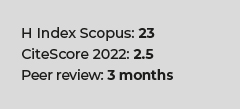Evaluation of the cost-effectiveness of two alternative human papillomavirus vaccines as prophylaxis against uterine cervical cancer
DOI:
https://doi.org/10.17843/rpmesp.2016.333.2294Keywords:
Papillomavirus vaccines, Cervical intraepithelial neoplasia, Condylomata acuminata, Cost-benefit analysisAbstract
Objectives. To determine the cost-effectiveness of human papillomavirus (HPV) vaccination and cervical lesion screening versus screening alone for the prevention of uterine cervical cancer (UCC). Materials and methods. This cost-effectiveness evaluation from the perspective of the Ministry of Health employed a Markov model with a 70-year time horizon and three alternatives for UCC prevention (screening alone, screening + bivalent vaccine, and screening + quadrivalent vaccine) in a hypothetical cohort of 10-year-old girls. Results. Our model, which was particularly sensitive to variations in coverage and in the prevalence of persistent infection by oncologic genotypes not included in the vaccine, revealed that HPV vaccination and screening is more cost-effective than screening alone, assuming a payment availability from S/ 2 000 (US dollars (USD) 1 290.32) per subject. In the deterministic analysis, the bivalent vaccine was marginally more cost-effective than the quadrivalent vaccine (S/ 48 [USD 30.97] vs. S/ 166 [USD 107.10] per quality-adjusted life-year, respectively). However, in the probabilistic analysis, both interventions generated clouds of overlapping points and were thus cost-effective and interchangeable, although the quadrivalent vaccine tended to be more cost-effective. Conclusions. Assuming a payment availability from S/ 2000 [USD 1,290.32], screening and vaccination were more cost-effective than screening alone. The difference in cost-effectiveness between the two vaccines lacked probabilistic robustness, and therefore the vaccines can be considered interchangeable from a cost-effectiveness perspective.Downloads
Download data is not yet available.
Downloads
Published
2016-08-16
Issue
Section
Original Article
How to Cite
1.
Bolaños-Díaz R, Tejada RA, Beltrán J, Escobedo-Palza S. Evaluation of the cost-effectiveness of two alternative human papillomavirus vaccines as prophylaxis against uterine cervical cancer. Rev Peru Med Exp Salud Publica [Internet]. 2016 Aug. 16 [cited 2024 Apr. 26];33(3):411-8. Available from: https://rpmesp.ins.gob.pe/index.php/rpmesp/article/view/2294



























